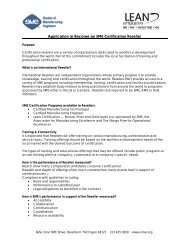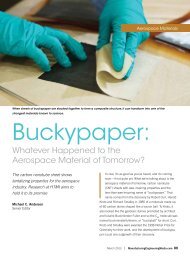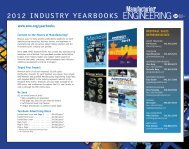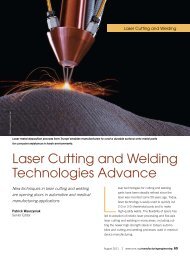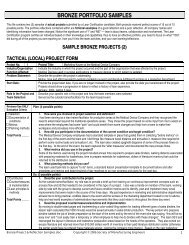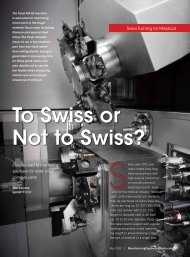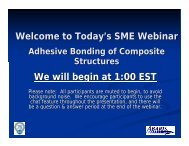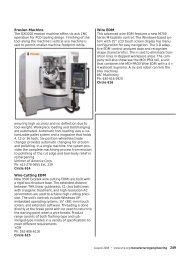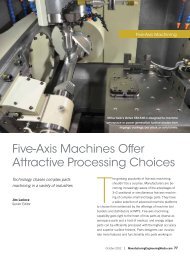The RAPID 2013 Conference & Exposition Directory - Society of ...
The RAPID 2013 Conference & Exposition Directory - Society of ...
The RAPID 2013 Conference & Exposition Directory - Society of ...
You also want an ePaper? Increase the reach of your titles
YUMPU automatically turns print PDFs into web optimized ePapers that Google loves.
ConferenCe Details<br />
patients are extremely active and desire to take part in numerous<br />
complex activities such as kayaking, skiing, scuba diving,<br />
etc. Prosthetics can accommodate, design, and manufacture<br />
numerous devices with standard materials and limb assemblies<br />
currently on the market to address these needs; however,<br />
some specialty attachments need to be custom designed and<br />
manufactured. Additive manufacturing is the most flexible and<br />
applicable solution to aid in these limited quantity production<br />
needs. Custom attachments are currently being manufactured at<br />
the 3D Medical Applications Center, WRNMMCB, for a multitude<br />
<strong>of</strong> functions such as “Shorty Feet” and “Mechanics Feet,” that<br />
allow a bilateral amputee to walk and maneuver under cars<br />
without attaching their full prosthetic; a “Pilot Foot” to help an<br />
amputee continue to pilot a plane; a “Hockey Hand” to allow a<br />
wounded warrior to play hockey with both hands on the stick; and<br />
a “Gun Holder” to allow an amputee to hold and fire a handgun.<br />
2–2:25 pm<br />
Design and Fabrication <strong>of</strong> a Variable Impedance<br />
Prosthetic Socket Through Multimaterial<br />
3D Printing Techniques<br />
David M. Sengeh, MS, Graduate Student, MIT Media Lab<br />
Today, nearly 100% <strong>of</strong> amputees report some form <strong>of</strong> discomfort<br />
in their prosthetic sockets. Our session will highlight work done<br />
in the design and manufacture <strong>of</strong> a multimaterial 3D-printed<br />
prosthetic socket by the Biomechatronics Group at MIT Media<br />
Lab and Stratasys. Custom-fitted prosthetic sockets designed with<br />
variable impedance determined by the underlying anatomy at each<br />
node within the prosthetic socket have been manufactured and<br />
used in lab settings. Our prototypes, which combine conventional<br />
manufacturing processes and 3D printing, have been used outside<br />
the lab in a recent investigation. <strong>The</strong> combination <strong>of</strong> both CAD/<br />
CAM and conventional materials and processes gives us the best<br />
<strong>of</strong> both worlds: structural integrity and variable impedance to<br />
increase the comfort level <strong>of</strong> amputees.<br />
2:30–2:55 pm<br />
Guided Decision Making in Aortic Aneurysms Using<br />
Patient Specific 3D Reconstructions and Printed<br />
Models: A Case Study<br />
Todd Pietila, B.SC., Application Engineer, Materialise USA<br />
Objective: We demonstrate a case <strong>of</strong> a complex aortic dissection<br />
operated 11 years ago, presented recently with a fast growing<br />
aneurysm in the distal arch and descending aorta. Closure<br />
was tried unsuccessfully with a small occluder. <strong>The</strong> case was<br />
further investigated with a novel method <strong>of</strong> 3D reconstruction<br />
and additive manufacturing. <strong>The</strong> objective <strong>of</strong> this study was to<br />
evaluate if the patient-specific 3D reconstruction and 3D-printed<br />
model provides information on the failure <strong>of</strong> the first intervention,<br />
and reveals other options for treatment.<br />
Conclusions: This novel approach <strong>of</strong> 3D reconstruction as well as<br />
3D printing convincingly showed the failure <strong>of</strong> the first occluder<br />
position to resolve the problem. It revealed other reentries into<br />
the false lumen which were not visible on the normal CT scan.<br />
<strong>The</strong>refore, we conclude that 3D reconstruction as well as 3D<br />
printing can help in planning and follow-up in such complex<br />
surgical/interventional cases.<br />
3–3:25 pm<br />
3D Printing Advances Patient-Specific Biomedical<br />
Engineering Modeling and Experimentation<br />
William W. Dahl, Vice President, Marketing and Communications,<br />
Solidscape, Inc.<br />
David H. Frakes, PhD, Assistant Pr<strong>of</strong>essor, Arizona State<br />
University, School <strong>of</strong> Biological and Health Systems Engineering<br />
John Wigand, MME, Vice President <strong>of</strong> Product Development &<br />
Strategy, Solidscape, Inc.<br />
Cerebral aneurysms affect 1 in 50 people and cause nearly<br />
20,000 deaths in the United States every year. With endovascular<br />
treatments as the standard <strong>of</strong> care for cerebral aneurysms,<br />
anatomically correct, transparent aneurysm models for fluid<br />
dynamic experiments are needed in improving device design and<br />
flow knowledge. While direct-from-RP approaches to transparent<br />
modeling have come a long way, they are currently not wellsuited<br />
for accurate fluid dynamic experimentation. We present a<br />
wax-based RP and lost-core methodology as an alternative that is<br />
cost-and-time-effective in creating transparent, scale aneurysm<br />
36 sme.org/rapid





